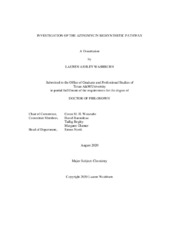| dc.description.abstract | The azinomycins are hybrid nonribosomal peptide and polyketide natural products isolated from Streptomyces sahachiroi. They are of interest due to their antitumor and broad antibiotic activity, which comes from the ability to form interstrand crosslinks with dsDNA through electrophilic epoxide and aziridine rings. Fermentation studies using ¹⁸O₂ identified oxygen atoms present in azinomycin installed through enzymatic oxidation. Four oxygens were identified, including the oxygen of the epoxide moiety responsible for azinomycin’s activity.
Due to a large portion of azinomycin biosynthesis occurring by nonribosomal peptide synthetase and polyketide synthase enzymes, a probe was developed to directly trap and characterize thioester-bound intermediates commonly found in these systems. The method was developed with the PKS AziB and validated the previous result of 2-methylbenzoic acid production by AziB. The probe was then used to identify intermediates bound to the NRPS AziA3 isolated from the azinomycin producing organism. These studies determined AziA3 bound the final epoxide moiety, with only condensation with the naphthoate and azabicycle to be performed.
The naphthoate moiety plays a key role in DNA-azinomycin adduct formation. To further study AziB’s role in naphthoate formation, domain separation was used to increase protein expression, yield, and efficiency of post-translational modification. The separated domains were still active when incubated together. Additionally, AziG’s role was validated in vivo and the ΔaziG strain was used to probe the ability to produce benzoic-azinomycin derivatives.
The azabicycle moiety is the most complex of the four azinomycin moieties. Previous studies showed glutamic acid is the precursor to this moiety, but it does not contain the two carbons necessary for aziridine ring formation. AziC5 and AziC6 were identified as domains of a thiamin dependent transketolase responsible for installing the final two carbons. This result establishes the final carbon framework of the azabicycle and azinomycin. Additionally, gene disruption and complementation studies were performed with aziW to determine azinomycin production dependence on the amino-acyl carrier protein.
These studies will help guide future in vitro reconstitutions, gene disruptions, and synthetic biology efforts to produce azinomycin and azinomycin analogues that can be used in further cancer therapy development studies. | en |


